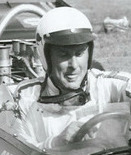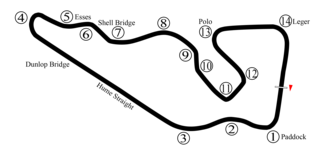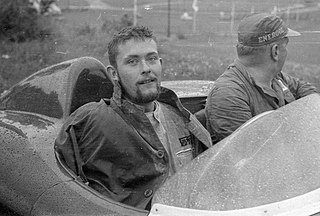
Graham Peter McRae was a racing driver from New Zealand.
Connew Racing Team, commonly known as Connew, was a short lived British Formula One constructor. Founded in 1971 by Peter Connew, the team constructed a single car, the PC1. The first monococque had to be aborted due to a change in regulations and the second tub was known as PC2. However, record books show the car driven by Migault and others as PC1. The intent was to compete in the Formula One World Championship in 1972, but a lack of financial and technical resources meant that the car only managed to start in one championship race, the 1972 Austrian Grand Prix, with French driver François Migault at the wheel. Following the Austrian race, the car competed in a handful of non-championship races before being converted to meet Formula 5000 specifications for the 1973 season. The chassis was damaged beyond repair during the season finale at Brands Hatch and the team closed.

Formula 5000 was an open wheel, single seater auto-racing formula that ran in different series in various regions around the world from 1968 to 1982. It was originally intended as a low-cost series aimed at open-wheel racing cars that no longer fit into any particular formula. The '5000' denomination comes from the maximum 5.0 litre engine capacity allowed in the cars, although many cars ran with smaller engines. Manufacturers included McLaren, Eagle, March, Lola, Lotus, Elfin, Matich and Chevron.

Warwick Farm Raceway was a motor racing facility which was in operation from 1960 to 1973. Warwick Farm Raceway hosted numerous major events during its life such as the Australian Grand Prix and rounds of both the Australian Touring Car Championship and the Tasman Series.

The 1971 Australian Grand Prix was a motor race held at Warwick Farm Raceway in New South Wales, Australia on 21 November 1971. It was open to Racing Cars complying with either Australian Formula 1 or Australian Formula 2 regulations.
The 1975 Tasman Series,, was a motor racing competition open to Racing Cars complying with the Tasman Formula. Contested over eight rounds in New Zealand and Australia beginning on 5 January and ending on 23 February, it was the twelfth and final Tasman Series. The series was organised jointly by the Motorsport Association of New Zealand and the Confederation of Australian Motorsport and was promoted as the Peter Stuyvesant International Series for the 1975 Tasman Championship.

The Lola T330 was an open-wheel formula race car, designed, developed and built by Lola Cars, for Formula 5000 racing, in 1973.
The McLaren M18 is an open-wheel Formula 5000 racing car designed and made by McLaren in 1971.

The 19th International Gold Cup was a non-championship Formula One race, which was held on the Oulton Park circuit, located near Tarporley, Cheshire, England on 29 May 1972.

The Lola T430 is an open-wheel formula race car, designed, developed and built by British manufacturer and constructor Lola Cars, for Formula 5000 racing, in 1976.

The Lola T140 was an open-wheel formula race car, designed, developed and built by Lola Cars, for Formula 5000 racing, in 1968.

The Lola T190 was an open-wheel formula race car, designed, developed and built by Lola Cars, for Formula 5000 racing, in 1969. A total of 17 models were produced.
The Surtees TS11 is an open-wheel Formula 5000 race car, designed, developed and built by Surtees in 1972. It is closely based on the Surtees TS9 Formula One car. It is powered by a 302 cu in (5 L) Chevrolet engine. Dutchman Gijs van Lennep won the 1972 Rothmans European Formula 5000 Championship driving the TS11, finishing the season with 65 points, and winning two races. It also contested in eight non-championship Formula One Grand Prix races, with its best results being two ninth-place finishes.
The 1971 Rothmans F5000 European Championship was a motor racing series for Formula 5000 cars. The series was organized in the United Kingdom by the British Racing and Sports Car Club but also included European rounds. It was the third of seven annual European Formula 5000 Championships to be contested between 1969 and 1975, and the first to carry the Rothmans F5000 European Championship name. The championship was won by Frank Gardner, driving a Lola T192 and a Lola T300.
Keith Holland is a British former racing driver from England who competed in various classes of racing in the 1960s and 1970s. He is known for winning the 1969 Madrid Grand Prix in a Formula 5000 car in a field which contained several Formula One entries. He was also a regular competitor in the British Formula 5000 Championship finishing third in the title standings on two occasions.

Ulf Norinder was a racing driver from Sweden who competed in multiple classes including non-championship Formula One and the Le Mans 24 hour race in the 1960s and 1970s.
The Eagle Mk.5 was an open-wheel race car designed and built by Eagle for use in Formula 5000 racing, which the team used to make their competitive racing debut in 1968, and competed until 1972. The Eagle Mk.5 was powered by the commonly used 5.0-liter Chevrolet V8 engine.

The Chevron B24 was a Formula 5000 racing car developed by Chevron Cars in 1972.

The McLaren M22 is an open-wheel race car, designed and developed by McLaren, to compete in Formula 5000 racing in 1972. Like it predecessors, The McLaren M22 was manufactured in large numbers. Built close to the weight limit, it was very light and was powered by a 500+ hp Chevrolet V8 engine. The cars were not actually manufactured by McLaren itself, but by the British racing car manufacturer Trojan, as with previous models. This would turn out to be the last Trojan-built McLaren F5000 car.
The Surtees TS5 was a Formula 5000 racing car, designed, developed, and built by Surtees between 1969 and 1970.












